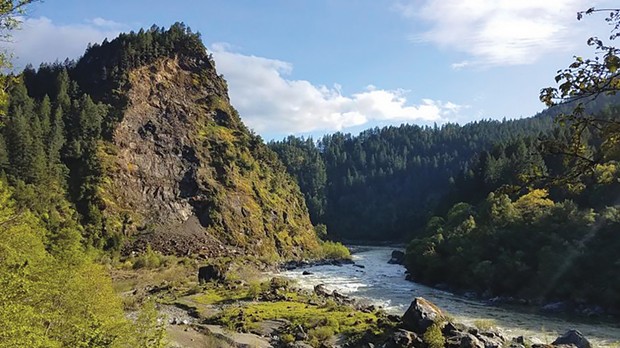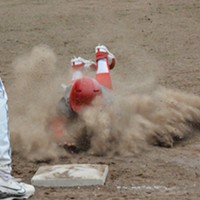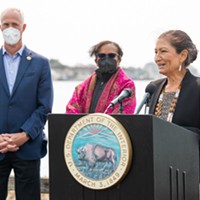Thursday, December 8, 2022
Karuk Sacred Lands Legislation Moves Forward
Posted By Kimberly Wear @kimberly_wear on Thu, Dec 8, 2022 at 1:01 PM
A little more than one year after being introduced by North Coast Rep. Jared Huffman, the Katimiîn and Ameekyáaraam Sacred Lands Act has passed out of the House Natural Resources Committee, bringing a nearly decade-long effort by the Karuk Tribe to once again care for these lands one step closer to fruition.
The 1,200 acres of U.S. Forest Service land that would be transferred to the tribe under the legislation includes a mountain known as á›uuyich to the Karuk people, for whom it is the center of the world, that sits at the confluence of the Klamath and Salmon rivers as well as the nearby historic village of Katimiîn, where the tribe's annual world renewal ceremony to restore balance to the universe takes place, and Ameekyáaraam, site of the Jump Dance and First Salmon Ceremony.
“Natural resource stewardship of land, wildlife, plants, and water is at the core of the Karuk people’s culture and identity," Huffman said in the announcement. "Yet 95 percent of their aboriginal territory is currently under federal management, undermining the tribe’s ability to exercise traditional practices that have been passed down since time immemorial.”
Passing the historic legislation, Huffman noted, corrects an “historic injustice.”
The Karuk Tribe currently only has a special permit to access the land included in Huffman's bill for ceremonial purposes, but that is not always guaranteed and sometimes the ceremonies are interrupted, even if not intentionally, mainly by river rafters.
In an interview with the Journal last year, Karuk Tribal Chair Russell “Buster” Attebery said the areas located in parts of Humboldt and Siskiyou counties are integral to the history, religion, culture and identity of the Karuk Tribe and their return "will ensure the Karuk culture and way of life can endure for future generations."
Read the full release from Huffman's office below:
The 1,200 acres of U.S. Forest Service land that would be transferred to the tribe under the legislation includes a mountain known as á›uuyich to the Karuk people, for whom it is the center of the world, that sits at the confluence of the Klamath and Salmon rivers as well as the nearby historic village of Katimiîn, where the tribe's annual world renewal ceremony to restore balance to the universe takes place, and Ameekyáaraam, site of the Jump Dance and First Salmon Ceremony.
“Natural resource stewardship of land, wildlife, plants, and water is at the core of the Karuk people’s culture and identity," Huffman said in the announcement. "Yet 95 percent of their aboriginal territory is currently under federal management, undermining the tribe’s ability to exercise traditional practices that have been passed down since time immemorial.”
Passing the historic legislation, Huffman noted, corrects an “historic injustice.”
The Karuk Tribe currently only has a special permit to access the land included in Huffman's bill for ceremonial purposes, but that is not always guaranteed and sometimes the ceremonies are interrupted, even if not intentionally, mainly by river rafters.
In an interview with the Journal last year, Karuk Tribal Chair Russell “Buster” Attebery said the areas located in parts of Humboldt and Siskiyou counties are integral to the history, religion, culture and identity of the Karuk Tribe and their return "will ensure the Karuk culture and way of life can endure for future generations."
Read the full release from Huffman's office below:
Washington, D.C. – Today, Rep. Jared Huffman’s (D-San Rafael) legislation H.R. 6032, the Katimiîn and Ameekyáaraam Sacred Lands Act, passed out of the House Natural Resources Committee. The legislation would place federal lands located in Humboldt and Siskiyou counties in California into trust for the Karuk Tribe.
Click here to view Rep. Huffman’s remarks on this bill at the Natural Resources Subcommittee for Indigenous Peoples Hearing in September.
“Katimiîn and its surrounding acres are not only majestic, they are central to Karuk history, religion, traditions, and identity. Placing them in trust ensures that the Karuk culture and way of life can endure for future generations,” Rep. Jared Huffman said. “Natural resource stewardship of land, wildlife, plants, and water is at the core of the Karuk people’s culture and identity. Yet 95% of their aboriginal territory is currently under federal management, undermining the tribe’s ability to exercise traditional practices that have been passed down since time immemorial. By passing this legislation out of the Natural Resources Committee, we are one step closer to returning sacred ground to the Karuk Tribe, correcting a historic injustice.”
Background
For Karuk people, the land identified in this legislation is the center of the world. The historical village and ceremonial site of Katimiîn is the location of a final series of annual Pik-ya-vish world renewal ceremonies.
Pik-ya-vish translates as “to fix it,” how Karuk people approach their responsibility to keeping these places in balance with their cultural and spiritual values. Ameekyáaraam, just down river from Katimiîn, is the site of Jump Dance and First Salmon Ceremony – both vital components of world renewal ceremonies and for pre-contact inter-tribal coordination of fish harvest up and down the river to ensure long-term sustainability of salmon runs.
These ceremonies were also ways to keep the world in balance between individuals and families. This area is essential to inter-generational teaching and learning needed to ensure future generations of Karuk people know and understand Karuk culture and customs.
Currently the tribe has a Special Use Permit with the United States Forest Service (USFS) that allows access to the grounds for ceremony. This access is not guaranteed and in some years the tribe is interrupted by public intrusions during private and sacred components of the world renewal ceremonies.
Only USFS lands will transfer to the tribe; all private lands, allotments and existing rights associated with those will be excluded. Senators Padilla and Feinstein sponsor a companion bill in the Senate (S.4439). A copy of the legislation can be found here. A map of the Katimiîn area can be found here.
Speaking of...
Readers also liked…
more from the author
-
Eureka Man Killed in SoHum Crash
- Jul 1, 2024
-
Caltrans Selects Tunnel Option for Last Chance Grade
- Jun 18, 2024
-
Kyle Steven Wear: 1970 —2024
- Jun 16, 2024
- More »



































